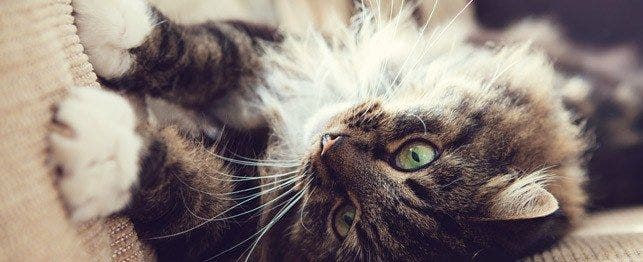
How to Stop Cats from Scratching Furniture
Inappropriate scratching can be a difficult and frustrating behavior for cat owners. There are multiple tips and techniques you can use to minimize this behavior. Cats use scratching for play, as well as a way to mark their territory. Scratch marks, the scent from the glands in their paws, and leftover claw sheaths show a cat’s territory and dominance.
Ways to Stop Cat Scratching
First and foremost in deterring cats from scratching furniture is providing indoor scratching posts. This gives cats an outlet to exhibit play behavior and mark their territory in an acceptable manner. You can either purchase pieces of cat furniture or make your own, using items like cardboard, sisal rope, and fabric. When your cat uses their approved scratching furniture, they should be rewarded as a method of positive reinforcement.
Trimming your cat’s nails every 4-6 weeks (depending on the cat) can also minimize the desire to scratch furniture. It’s even a great way to keep your cat healthy, since short nails help prevent medical conditions like ingrown claws and allow for early identification of masses or growths around the nail beds.
If there is a particular piece of furniture your cat is targeting, there are products that can be applied to make it less appealing. Stick double-sided tape to the corners of tables and couches, since the adhesive will act as a deterrent. Other options include sandpaper or an upside-down carpet runner. Putting a scratching post near the targeted furniture can also help alleviate the urge.
Nail Covers and Care Measures
Another option to consider is gel nail caps, which can be purchased online and at local pet stores. These caps are easily glued on, sized specifically for your pet, and stay on for 4-6 weeks, varying based on the product and your cat’s tolerance level. If you have trouble getting them on the first time around, seek out instructional videos on YouTube.
These caps cover the sharp part of the claw, preventing furniture from being scratched or damaged. If your cat has nail caps on, the nail beds should be examined before each application to look for irritation, redness, and swelling. If any of these signs are observed, nail caps shouldn’t be applied and your pet’s nails should be evaluated by a veterinarian for infections, ingrown nails, and inappropriate cap placement. Ingrown nails are painful and can create deep seated infections in the paw pads.
Treatment of ingrown nails include:
- Trimming the problem nail
- Pain control
- Localized treatment by cleaning the paw
- Systemic treatment depending on severity of infection (may need oral antibiotics)
Using a spray bottle or compressed air can also deter cats from scratching unwanted items, though this may only work as a short-term solution, and requires persistence and consistency.
The Drawbacks of Declawing
Declawing is a dated method for resolving cat scratching behaviors that has recently come under scrutiny. This is a surgical procedure where the third phalanx of the digit is removed, which is the most distal part of the cat’s toe. This process removes the claw and the last piece of bone on each digit.
This surgical procedure requires anesthesia and is prone to the following complications:
- Hemorrhage
- Infection
- Chronic pain
- Claw regrowth
- Arthritis
In 2019, New York was the first US state to ban declawing in cats, following bans in the UK and several Canadian provinces. It is also illegal in the US cities of Denver, San Francisco, and Los Angeles. Declawing should no longer be used as a procedure to stop cats from scratching furniture. Behavioral training and positive reinforcement are the best ways to stop unwanted scratching.